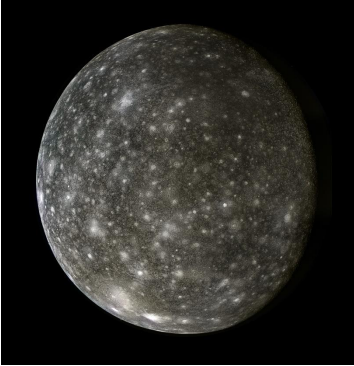Ahmedabad
(Head Office)Address : 506, 3rd EYE THREE (III), Opp. Induben Khakhrawala, Girish Cold Drink Cross Road, CG Road, Navrangpura, Ahmedabad, 380009.
Mobile : 8469231587 / 9586028957
Telephone : 079-40098991
E-mail: dics.upsc@gmail.com

Context: Researchers have recently uncovered compelling evidence suggesting the existence of ozone on Jupiters moon Callisto. This discovery illuminates the intricate chemical processes unfolding on icy celestial bodies within the Solar System, offering valuable insights into planetary science.
About Study:
• The study investigates the chemical evolution of SO2 astrochemical ice, primarily
composed of Sulphur dioxide (SO2), under ultraviolet irradiation.
• Researchers analyzed data from UV absorption spectra of irradiated ice samples.
• The analysis revealed a distinct signature indicating the formation of ozone.
• The stability of Callistos surface is highlighted, suggesting its potential role in preserving subsurface oceans or potential habitats beneath the icy crust.
About Callisto:
• Moon Count: Jupiter has the second-highest number of moons in the Solar System after Saturn.
• Callistos Ranking: Callisto is Jupiters third-largest moon and the third-largest moon in the Solar System, preceded by Ganymede and Titan.
• Composition: Callisto primarily consists of water ice, rocky materials, sulphur dioxide, and some organic compounds, making it a potential candidate for extraterrestrial life.
• Surface Features: Callistos surface is heavily cratered, suggesting a history of asteroid and comet impacts.
Ozone and its Importance:
• The ozone molecule consists of three oxygen atoms bonded together.
• The ozone layer is situated in the lower part of Earths stratosphere, approximately 15-35 kilometers above the ground.
• Acting as a shield, the ozone layer helps mitigate ultraviolet radiation levels on Earths surface.
• Without the ozone layer, increased ultraviolet radiation would render the planet uninhabitable for many species and disrupt entire ecosystems.
• Ultraviolet-B (UVB) and Ultraviolet-C (UVC) radiation, with wavelengths of 290-320 nanometers and 100-280 nanometers respectively, can damage DNA, induce mutations, and elevate the risk of skin cancer and cataracts in humans.
• Ultraviolet light can also hinder plant growth and have adverse effects on various organisms.
Conclusion:
Scientists are currently conducting studies on various celestial bodies within the Solar System that display indications of ozone presence. This discovery suggests the existence of stable atmospheric conditions on these celestial bodies. The detection of ozone raises intriguing possibilities regarding the potential for these celestial bodies to host life. By indicating the presence of stable atmospheric conditions, the presence of ozone opens up avenues for further exploration and investigation into the habitability of these distant worlds.

Address : 506, 3rd EYE THREE (III), Opp. Induben Khakhrawala, Girish Cold Drink Cross Road, CG Road, Navrangpura, Ahmedabad, 380009.
Mobile : 8469231587 / 9586028957
Telephone : 079-40098991
E-mail: dics.upsc@gmail.com
Address: A-306, The Landmark, Urjanagar-1, Opp. Spicy Street, Kudasan – Por Road, Kudasan, Gandhinagar – 382421
Mobile : 9723832444 / 9723932444
E-mail: dics.gnagar@gmail.com
Address: 2nd Floor, 9 Shivali Society, L&T Circle, opp. Ratri Bazar, Karelibaugh, Vadodara, 390018
Mobile : 9725692037 / 9725692054
E-mail: dics.vadodara@gmail.com
Address: 403, Raj Victoria, Opp. Pal Walkway, Near Galaxy Circle, Pal, Surat-394510
Mobile : 8401031583 / 8401031587
E-mail: dics.surat@gmail.com
Address: 303,305 K 158 Complex Above Magson, Sindhubhavan Road Ahmedabad-380059
Mobile : 9974751177 / 8469231587
E-mail: dicssbr@gmail.com
Address: 57/17, 2nd Floor, Old Rajinder Nagar Market, Bada Bazaar Marg, Delhi-60
Mobile : 9104830862 / 9104830865
E-mail: dics.newdelhi@gmail.com